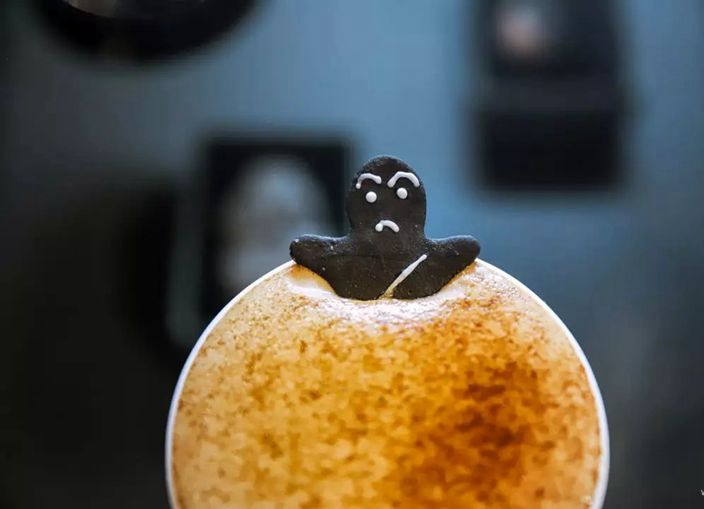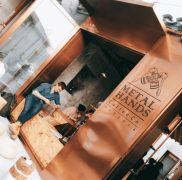What tools do you need for coffee? What do you have for drinking coffee? how much is a set of coffee drinking tools?

Professional coffee knowledge exchange more coffee bean information please follow the coffee workshop (Wechat official account cafe_style)
Time from a coffee tree to a cup of coffee
(don't bother to look for the picture, two minutes quick)
Coffee cherry: coffee trees begin to bear fruit eight or nine months after flowering, because the fruit is as bright red as a cherry, hence the name. There are two coffee seeds in each coffee cherry, namely coffee beans.
Treatment process: coffee beans are obtained from coffee cherries. The usual treatment processes are water washing, sun exposure, semi-washing and honey treatment.
Washing method: first rinse off the impurities of coffee cherries with a large amount of water, then remove the exocarp and pulp with a peeling machine, ferment for 18-36 hours, dissolve the insoluble pectin with fermentation bacteria, then clean it, and finally dry it to 9% of the water content. Use a sheller to remove the silver peel (the endocarp of coffee seeds, also known as "parchment").
The coffee beans obtained by washing method have less impurities, bright taste and strong sour taste.
Sun method: the coffee cherry will be exposed to the sun for 3-4 weeks, turn several times a day to make it heated evenly, after the water content reaches 9%, peel off.
The beans obtained by the sun method have a complete natural mellow taste, soft sour taste and even bitter taste.
Semi-washing method: similar to the water washing method, remove the exocarp and part of the flesh after drying, soak again, and grind off the pulp with a special machine to get beans.
Honey treatment: remove the exocarp of coffee cherries, retain the sticky pulp for sun drying, and then remove the pulp and silver peel.
The beans obtained by honey treatment can retain the original sweet flavor, usually with light caramel and fruity aromas.
Roasting: after the raw beans are obtained from coffee cherries, they are roasted to release the aroma of coffee. From raw beans, shallow baking, medium baking to deep baking, moisture is released again and again, weight is reduced, volume slowly expands, color deepens, oil is gradually released, and the texture becomes brittle and hard.
Grinding: raw beans are roasted into ripe beans, and then ground into coffee powder, the thickness of the powder will affect the speed and time of contact with the water. Even for the same coffee beans, there are differences in flavor with different grinding thickness.
(I am still walking on the road of grinding beans by hand.)
Extraction (follicle is probably my unprofessional word): water releases the soluble substances of coffee minutes, the whole process is affected by water temperature, flow speed, pressure, time and other aspects, which is the key link to affect the final taste of coffee.
A variety of extraction tools, Ruyi coffee machine, Philharmonic pressure, siphon pot, Belgian pot, mocha pot, ice drop kettle, French pressure kettle, hand punch + filter cup.
Espresso machine: essential equipment in a coffee shop, single coffee with or without, Italian concentrate, latte, mocha, cappuccino, macchiato these are the basic menu.
(the picture is from the Internet)
Philharmonic pressure: similar to the principle of a syringe, first inject the same weight coffee powder and hot water for 25s, then second inject the required hot water, stir and place 2min, cover the filter tightly, put the cup upside down on the filter, and press the coffee upside down for about 20s.
(high energy ahead, a big wave of rough sketches coming.)
Siphon pot: the way to bring chemical utensils into the extraction of coffee, the main principle is the pressure difference.
Put the coffee powder in the upper pot, heat the aquatic product pressure in the lower pot, put the water pressure into the upper pot, stir so that the coffee powder and water are fully mixed, remove the fire source, lower the cooling pressure in the lower pot, the coffee liquid falls back to the lower pot through the filter, and remove the upper pot to get coffee.
Belgian pot: also known as balanced stopper, invented by the British shipbuilder, there is a chemical experimental vessel style, popular in the European royal family, so the appearance is gorgeous and elegant.
First of all, after the kettle is filled with water, the balance tilts to the right, the alcohol lamp heats the kettle, the steam rushes open the piston at the top of the kettle, and the hot water enters the coffee pot through the thin tube, which is fully mixed with the coffee. Because of the siphon principle, the hot coffee will flow back to the right kettle through the filter at the bottom of the thin tube, leaving the coffee grounds at the bottom of the left kettle, and then turn on the faucet to have coffee to drink.
Mocha pot: the principle is similar to the siphon pot, the siphon pot that stops abruptly in the middle of it?
Pour hot water into the pot, cover the powder trough, pay attention to the hot water can not immerse the powder trough, add finer coffee powder in the powder trough, tighten the upper pot and the lower pot, heat the mocha pot on the stove, let the kettle boil and rush through the powder trough, quickly extract and reach the upper pot, you can pour out the coffee. Experience tells me that there is always some coffee powder at the bottom of the cup.
Curling kettle: originated in the Netherlands, it takes several hours to extract coffee with ice water or ice cubes.
First close the water drop regulating valve, add ice water to the kettle, pour the coffee powder into the coffee powder cup and soak it with a small amount of water, take a special filter cloth or a piece of No. 6 pill-shaped filter paper and spread it flat on the coffee powder, slowly open the water valve and let the water droplets drop on the pill filter paper at a standard speed of 7 drops for 10 seconds, adjusting once every 2 hours. Deep-roasted coffee beans should be selected and filtered for about 8-10 hours (preferably refrigerated). Long-term low temperature extraction can make coffee powder 100% infiltrate and remove bitterness. The coffee is clear and amber, full-bodied and smooth, not sour and astringent, and does not hurt the stomach.
French kettle: this seems to be a lazy kettle. At first I thought it was used to make tea, uh.
The operation is very simple, pour coffee powder, pour hot water, cover the filter, static 3min, slowly press the bar to the end, OK, you can pour out the coffee to drink. Because it is simple and rough, it is inevitable that there will be some coffee powder, so the coffee powder particles should not be too fine.
Hand flushing pot + filter cup: hand flushing due to human factors, often the product does not have too stable taste, but this is also the fun of hand flushing, even with the same beans, each cup can have a different feeling, always bring surprises.
Hand flushing, like the name, holds a kettle to artificially control the flow and speed of water, infiltrate the coffee powder and extract the coffee. The filter cup is divided into separate type and Chemex type, the operation difference is that the former pours the coffee powder into the dry filter paper, while the latter puts the filter paper into the filter cup, it needs to soak the filter paper to fit the filter cup and then pour the coffee powder. After that, pour hot water into the coffee powder, steam for 20-30s, and then pour in hot water to extract coffee. Coffee powder thickness, water temperature, water flow size, flow speed, water volume, steaming time, extraction time, will affect the taste and taste of coffee, let's make a cup of hand, you can always get your own cup of coffee.
The article that was planned to be completed in two hours was written for two days, but I still left a hole for myself. I didn't mention the coffee tree at the beginning of the sentence from the coffee tree to a cup of coffee, because I knew full well that the coffee origin and the classification and characteristics of coffee beans needed to refer to more information. and it needs a huge work, so just treat it as an assignment for yourself, and then write it separately.
Originally thought that drinking coffee is just a simple thing, when really want to know, only found that only superficial, the more understanding, but found that the more ignorant. Every knowledge, or every skill, is not easy to acquire, and there are always some hardships that no one else can know, which can only be maintained and improved through continuous learning and practice.
Even if you make yourself look ignorant now, every new thing that inspires your curiosity always opens a window with a different scenery and a door that is different from the usual. As for seeing how far you go, it's all in your choice and action, but at least it offers an opportunity with infinite possibilities, doesn't it?
Reference materials:
1. "Food paste 02: just for a good cup of coffee"
2. Interesting coffee APP
3. Network articles
END
Important Notice :
前街咖啡 FrontStreet Coffee has moved to new addredd:
FrontStreet Coffee Address: 315,Donghua East Road,GuangZhou
Tel:020 38364473
- Prev

[recommended for entry equipment] what are the types of hand coffee maker? which brand is good for hand coffee equipment?
Professional coffee knowledge exchange more coffee bean information Please pay attention to the coffee workshop (Wechat official account cafe_style) Coffee utensils are various, a little configuration, slowly more and more tools, while studying, while playing the process, the coffee also becomes interesting, the home utensils have been tidied up, the process of separation, the experience of life has also been cleaned up
- Next

Where can I find a coffee store in Guangzhou to recommend _ what are the nine sets of coffee utensils
Professional coffee knowledge exchange more coffee bean information please follow the coffee workshop (Wechat official account cafe_style) IKEA IKEA coffee utensils, it feels that it is still too few. It is the basic style, and there are no various styles to choose from.
Related
- Beginners will see the "Coffee pull flower" guide!
- What is the difference between ice blog purified milk and ordinary milk coffee?
- Why is the Philippines the largest producer of crops in Liberia?
- For coffee extraction, should the fine powder be retained?
- How does extracted espresso fill pressed powder? How much strength does it take to press the powder?
- How to make jasmine cold extract coffee? Is the jasmine + latte good?
- Will this little toy really make the coffee taste better? How does Lily Drip affect coffee extraction?
- Will the action of slapping the filter cup also affect coffee extraction?
- What's the difference between powder-to-water ratio and powder-to-liquid ratio?
- What is the Ethiopian local species? What does it have to do with Heirloom native species?

